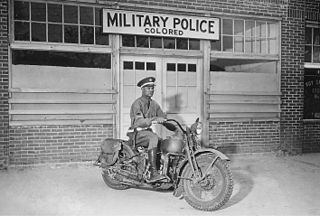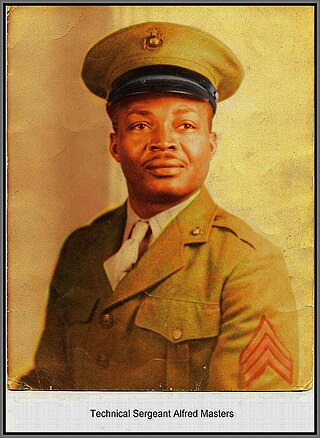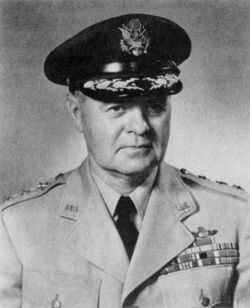Desegregation is the process of ending the separation of two groups, usually referring to races. Desegregation is typically measured by the index of dissimilarity, allowing researchers to determine whether desegregation efforts are having impact on the settlement patterns of various groups. This is most commonly used in reference to the United States. Desegregation was long a focus of the American civil rights movement, both before and after the United States Supreme Court's decision in Brown v. Board of Education, particularly desegregation of the school systems and the military. Racial integration of society was a closely related goal.

Asa Philip Randolph was an American labor unionist and civil rights activist. In 1925, he organized and led the Brotherhood of Sleeping Car Porters, the first successful African-American led labor union. In the early Civil Rights Movement and the Labor Movement, Randolph was a prominent voice. His continuous agitation with the support of fellow labor rights activists against racist unfair labor practices, eventually helped lead President Franklin D. Roosevelt to issue Executive Order 8802 in 1941, banning discrimination in the defense industries during World War II. The group then successfully maintained pressure, so that President Harry S. Truman proposed a new Civil Rights Act and issued Executive Orders 9980 and 9981 in 1948, promoting fair employment, anti-discrimination policies in federal government hiring, and ending racial segregation in the armed services.

Executive Order 9981 was issued on July 26, 1948, by President Harry S. Truman. This executive order abolished discrimination "on the basis of race, color, religion or national origin" in the United States Armed Forces, and led to the re-integration of the services during the Korean War (1950–1953). It was a crucial event in the post-World War II civil rights movement and a major achievement of Truman's presidency.

Executive Order 8802 was signed by President Franklin D. Roosevelt on June 25, 1941, to prohibit ethnic or racial discrimination in the nation's defense industry. It also set up the Fair Employment Practice Committee. It was the first federal action, though not a law, to promote equal opportunity and prohibit employment discrimination in the United States. Many citizens of Italian or German ethnicity were affected by World War II and this was impeding the war effort and lowering morale. This ethnic factor was a major motivation for Roosevelt. The President's statement that accompanied the Order cited the war effort, saying that "the democratic way of life within the nation can be defended successfully only with the help and support of all groups," and cited reports of discrimination:
There is evidence available that needed workers have been barred from industries engaged in defense production solely because of considerations of race, creed, color or national origin, to the detriment of workers' morale and of national unity.

The 80th United States Congress was a meeting of the legislative branch of the United States federal government, composed of the United States Senate and the United States House of Representatives. It met in Washington, D.C. from January 3, 1947, to January 3, 1949, during the third and fourth years of Harry S. Truman's presidency. The apportionment of seats in this House of Representatives was based on the 1940 United States census.

Isaac Woodard Jr. was an American soldier and victim of racial violence. An African-American World War II veteran, on February 12, 1946, hours after being honorably discharged from the United States Army, he was attacked while still in uniform by South Carolina police as he was taking a bus home. The attack and his injuries sparked national outrage and galvanized the civil rights movement in the United States.

Harry S. Truman was the 33rd president of the United States, serving from 1945 to 1953. A leader of the Democratic Party, he previously served as the 34th vice president from January to April 1945 under Franklin Roosevelt and as a United States senator from Missouri from 1935 to January 1945. Assuming the presidency after Roosevelt's death, Truman implemented the Marshall Plan to rebuild the economy of Western Europe and established both the Truman Doctrine and NATO to contain the expansion of Soviet communism. He proposed numerous liberal domestic reforms, but few were enacted by the conservative coalition that dominated the Congress.
Charles Luckman was an American businessman, property developer, and architect known for designing landmark buildings in the United States such as the Theme Building, Prudential Tower, Madison Square Garden, and The Forum. He was named the "Boy Wonder of American Business" by Time magazine when president of the Pepsodent toothpaste company in 1939. Through acquisition, he later became president of Lever Brothers. Luckman would later collaborate with William Pereira, in which the two would form their architectural firm, Pereira & Luckman, in 1950. Pereira & Luckman would later dissolve by 1958, parting ways for both himself and Pereira. Luckman would continue successfully with his own firm, Charles Luckman Associates. Luckman retired from the firm, although he would still be present.
The President's Committee on Civil Rights was a United States presidential commission established by President Harry Truman in 1946. The committee was created by Executive Order 9808 on December 5, 1946, and instructed to investigate the status of civil rights in the country and propose measures to strengthen and protect them. After the committee submitted a report of its findings to President Truman, it disbanded in December 1947.

Philleo Nash was a government official, anthropologist, and politician. A member of the Democratic Party, he was Commissioner of the U.S. Bureau of Indian Affairs (1961–1966) during the presidencies of John F. Kennedy and Lyndon B. Johnson. Previously, he was the 33rd Lieutenant Governor of Wisconsin (1959–1961) and was chairman of the Democratic Party of Wisconsin (1955–1957).

Richard Emmel Nugent was a lieutenant general in the United States Air Force who, among other positions, commanded the XXIX Tactical Air Command supporting the Ninth Army during World War II. His first five years of service as a second lieutenant were spent as a tank officer. In 1929 he transferred to the United States Army Air Corps during its five-year expansion program.

Charles Fahy was an American lawyer and judge who served as the 26th Solicitor General of the United States and later served as a United States circuit judge of the United States Court of Appeals for the District of Columbia Circuit.

Truman Kella Gibson, Jr. was an African-American businessman, attorney, government advisor, and later influential boxing promoter who played a unique and unheralded role in the Civil Rights Movement, primarily as a member of the "Black Cabinet" of Presidents Franklin D. Roosevelt and Harry S. Truman.

African Americans have served the U.S. military in every war the United States has fought. Formalized discrimination against black people who have served in the U.S. military lasted from its creation during the American Revolutionary War to the end of segregation by President Harry S. Truman's Executive Order 9981 in 1948. Although desegregation within the U.S. military was legally established with President Truman's executive order, full integration of African-American servicemen was not established until 1950 in the Navy and Air Force, 1953 in the Army, and 1960 in the Marine Corps.

The United States Marine Corps (USMC) is a desegregated force, made up of troops of all races working and fighting alongside each other. In 1776 and 1777, a dozen African American Marines served in the American Revolutionary War, but from 1798 to 1942, the USMC followed a racially discriminatory policy of denying African Americans the opportunity to serve as Marines. For more than 140 years, the Marines recruited primarily European Americans and Hispanic and Latino Americans, along with a few Asian Americans.
Racial segregation in the United States Armed Forces includes the separation of white and non-white American troops, bans on people of color serving in the military, and restrictions of people of color to supporting roles in the military. Since the American Revolutionary War, each branch of the Armed Forces has implemented different policies surrounding racial segregation. Though Executive Order 9981 officially ended segregation in the Armed Forces in 1948, some forms of racial segregation continued to be practiced in them until after the Korean War.
The Second Emancipation Proclamation is the term applied to an envisioned executive order that Martin Luther King Jr. and other leaders of the Civil Rights Movement enjoined President John F. Kennedy to issue. As the Emancipation Proclamation was an executive order issued by President Abraham Lincoln to free all slaves being held in states at war with the Union, the envisioned "Second Emancipation Proclamation" was to use the powers of the executive office to strike a severe blow to segregation.

Idwal Hubert Edwards CBE, born in Freedom, New York, was a lieutenant general in the United States Air Force; he was a distinguished commander, rated command pilot, combat observer and aircraft observer.

George Leon-Paul Weaver was an American labor leader, active in promoting civil rights both in the US and internationally. After serving as Assistant Secretary of Labor for International Affairs in both the Kennedy and Johnson administrations, he was in 1968 elected chair of the governing body of the UN's International Labour Organization. He was the first American to be named "Honorary Commander" in the Order of the Defender of the Realm, a Malaysian federal award for meritorious service to the country.
















